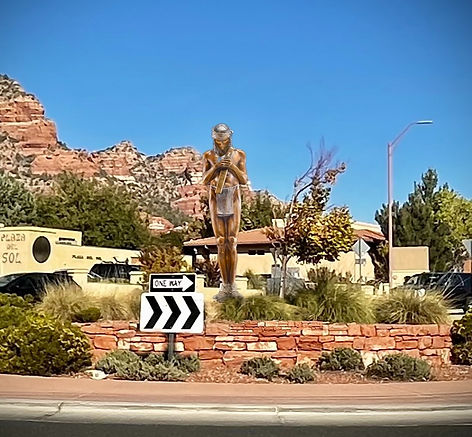
Village of Oak Creek
Roundabout Art Project
"Man in the Maze"
James Muir Artist Statement
“The longest journey is the journey within.” “There and back again - through the Labyrinth of Life, Man returns to the source bearing the gift of insights gained.” - James N. Muir The “Man-in-the-Maze”, symbol of Arizona’s First Nation People’s heritage, pays tribute to the Native Americans’ recognition of the Spirituality imbued in the Sacred Red Rocks, with the Village the “ Gateway”, specifically at the Northern Roundabout’s “entrance”, which is also where my own sculpting career began in 1980 in the Studio-apartment above “Plaza del Sol”. As a maze is a network of interconnecting paths designed to confuse the traveler, the Native American symbol traditionally called,” the man in the maze” is actually the man in the labyrinth. A labyrinth is an ancient unicursal path found in many cultures around the world, which depicts a spiritual journey in physical form. Labyrinths have been found in almost every religious tradition in at least the last five thousand years to include such diverse places as Egyptian tombs, Cretan coins, Celtic stones, Greece and even Minoan representations found in Arizona and New Mexico dating to the start of the Bronze Age, c 3000 to 1200 B.C. As noted, the “maze,” is actually a labyrinth and the legend has been used by the native cultures for centuries to help children understand the meaning of life: a visual allegory depicting the experiences and choices we make in our journey through life. It illustrates the search for balance- physical, mental, spiritual as well as social. Symbolically, the journey has been interpreted as either a journey out of the original darkness in the center (Tohono O’odham) or the reverse- a journey from the outer world into the spiritual center (Pima) where finds their dreams and goals and, when reached, the Sun God is there to greet us, bless us, and pass us into the next world. In actuality, both interpretations are correct in viewing the totality of the human spiritual journey out from the center of creation into the physical world and back again through the seeming “maze” that isn't a maze, to re-find our Divine Center. While there are many forms of labyrinth, depicted is a “Seven Path Classical Labyrinth.” Its’ circle with its seven rings, is a symbol of wholeness and unity and is, reflective of the world we live in and our longing for wholeness. This spiritual overview reveals the true significance of the twists and turns life's Path takes as actually having been guided by a Higher Power for the highest good of others and ourselves. It is a journey of Faith, and Divine Instinct, and since Faith comes from the heart, our traveler like the mythical vagabond flute player of yore, has been playing his guiding flute from the Heart. His flute is decorated with the blue feather of Truth coupled with the white feather of Surrender, under the all seeing eye of the Spirit Eagle soaring high above. With this his only possession, the Traveler stands at the threshold, reviewing at his feet the silver map of his Journey through the Labyrinth of Life, the winding path that adds up to the successful completion of his Journey to At-ONE-Ment- just “one small step for man, but a giant leap for mankind.”

Artist Biography
James N. Muir was born in Indianapolis, Indiana 1945. He attended the United States Military Academy at West Point for one and a half years and completed his B.S. Degree at Indiana University in 1970, while also having served six years in both the U.S. Army and Air Force. His professional art career as a self taught sculptor began in Sedona, Arizona in 1980 where he has continued to be a full-time professional artist for the past four decades. He owned his own bronze-casting foundry, Seraph M Fine Art Bronze, from 1982 to 1988 in Sedona, Arizona. He has completed over 100 sculptures to date. There are over 20 lifesize and monumental sculptures of Muir’ located in public locations in Arizona alone, and more than 60 other lifesize and monumental sculptures placed in public locations across the country and abroad. Allegorical Art is a term Muir uses to describe his art as being filled with symbolic meaning. Bridging the centuries from his historical military subjects to today’s social, political and spiritual commentary, his sculptures speak eloquently of Duty, Honor, Courage, and Justice, but above all, of Truth and the ultimate triumph of the Human Spirit. He has built upon the recognition gained initially as an historical military sculptor to create an ever-expanding array of artistic commentary exemplifying the highest qualities of man. Muir's early interest in history and the military was reinforced by his experiences as a West Point cadet and to which he also attributes the cementing of his personal “Code of Honor.” Muir’s ever-deeper involvement with horses, and his continuing quest for spiritual Truth, led him to Arizona in 1978 for the freedom and inspiration of the great American West. He ultimately settled in Sedona, Arizona and there embarked on a full-time career in sculpting, initially specializing in historical subjects. In 1990 he began to expand his work to include contemporary subjects and accepting commissions in lifesize and monumental. His meticulous attention to detail, coupled with an insightful grasp of the human experience resulted in exquisitely crafted and poignant bronzes. His works quickly gained the acclaim of collectors around the country. Some of the public collections where Muir’s work resides include the U.S. Cavalry Museum at Fort Riley, Booth Museum in Georgia, Gettysburg Battlefield Museum, Pearce Western Art Museum, Sons of The American Revolution Headquarters, University of Arizona, and the Atlanta Historical Society. Many of his sculptures that address today’s contemporary issues can be found in institutions and museums such as: Birkenau Museum at Auschwitz, Poland, El Paso Holocaust Museum, St. Louis University, Paul Harvey News Broadcasting Headquarters, George W. Bush, Sr. office, and some of the most prominent private collections in America. A long-term goal realized, was Muir’s first book, “Lanterns Along The Path”, published in 2004 with a second printing in 2005. The book was offered nationwide by Barnes & Noble. A labor of love, Muir spent nearly seven years writing the book that showcases his sculptures with a flowing narrative addressing the spirit of the human journey. Recognized as its own work of art: Muir received the “2004 Pinnacle Book Achievement Award” in the Inspirational Category. In June 2021, he released his sequel, “Lanterns Along the Path: Part II,” which continues the Allegorical narrative and personal insights as represented in his subsequent art from 2004 to present. In keeping with his deep spiritual convictions and social consciousness, Muir’s sculptural and philosophical works reflect the critical nature of the times in which we live. Whether historical or contemporary, “The golden thread that ties it all together is still his never-ending quest for the essence of life - for Truth in its purest form.”